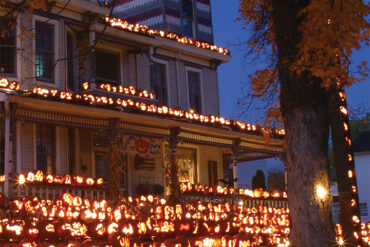The face of the Greater Huntington Parks and Recreation District retires after more than 30 years of service
By Kaylin Adkins
HQ 72 | WINTER 2010
Nestled in his office at the Greater Huntington Parks and Recreation District in Heritage Station, Jim McClelland couldn’t seem any more at home. Thank-you cards to local legislators are piled on his desk, and framed photographs of Huntington’s parks line the crisp white walls with oak wainscoting.
The 74-year-old director gently smiles, reminiscing of bygone days. He plans to graciously step aside from his beloved position, counting his blessings and harboring his passion for Huntington and its parks.
After more than 31 years of service at the GHPRD, McClelland retired October 31, leaving behind a foundation for future initiatives and an unforgotten legacy.
“I think it’s time for a new, fresh-air type of approach that is more contemporary in thought and action,” McClelland said. “When one’s been in a position for 31 years, it’s time that the park district work with people who are younger and not necessarily more energetic but certainly energetic. And I’m looking forward to doing other things.”
It is difficult to imagine a park project without McClelland at the helm of the planning and coordination. As director, he was involved in such projects as the playgrounds at Ritter Park in Huntington, trails in Ritter Park and along Four Pole Creek, the sprayground at April Dawn Park in Milton and others. McClelland, the GHPRD Board of Directors, staff members and governmental entities worked together to further the main goal of the district: to provide diverse services to everyone in the area.
McClelland said he loved seeing projects come to fruition – all while creating professional partnerships and personal friendships with the people he met along the way. His crowning glory was utilizing effective grant-writing techniques to provide the district with enough money to keep facilities active and carry out master plans for the parks.
“He had an ability to parlay what few dollars we have with a lot of other grant money and funding sources from various agencies out there,” said Jim Cummings, president of the GHPRD Board of Directors. “When I think of Jim, I think of nothing else but a through-and-through parks person who gave a great deal of attention to the planning and coordination of everything that’s done in the park system.”

When McClelland took over the director position, one of his first challenges was to develop a comprehensive strategy plan for the park system called Recovery Action Plan (RAP). RAP has been revised several times, and it set the parameters for the area’s park development. It also enabled the park board to prepare grants for federal assistance through the Land and Water Conservation Fund program. McClelland then worked with the commission, neighborhood organizations, architects and many other individuals to create facilities that have become staples of the Huntington community.
“I don’t have one project that’s a favorite, and one of the reasons for that is all of these facilities service different people,” he said. “Neighborhoods have various interests, whether it might be people who go to parks to bird- watch, walk, exercise, play a sport, play disc golf, splash in the sprayground or visit the Rose Garden. It’s so diverse that in one way or another, the park system covers the broad interests of people in all walks of life.”
Ed Tucker, owner of Edward Tucker Architects, worked with McClelland on several project designs, including master plans for Ritter Park, Heritage Station and other ventures.
“Professionally and personally, he was so pleasant to work with,” Tucker said. “He wanted to hear what your ideas and thoughts were. He certainly brought his vision to the table, but he was very respectful of what architects and landscape architects do.”
When McClelland arrived, Ritter Park, Rotary Park, Camp Mad Anthony Wayne and St. Cloud Commons were the prime recreational facilities within the district. The Spring Hill, Highland and Guyandotte cemeteries were also within the district’s jurisdiction and have been included since the park district’s creation in 1925.
“My philosophy in parks has always been that parks are the public’s estates,” McClelland said. “Not many of us can afford grand estates, but public parks are the people’s estates. The facilities, in a way, are their palaces. That’s what I’ve been dedicated to. Parks are the most democratic of all facilities and landscapes if you really think about it.”
Frank Hanshaw Jr., chair of the Huntington Rotary Park Committee, worked with McClelland on many projects and watched Rotary Park expand due to McClelland’s diligence.
“I’d say that Jim McClelland was not only an outstanding park director, but he was a magician,” Hanshaw said. “He just made those funds expand unbelievably.”
McClelland has had nearly 50 years in the parks and recreation field to perfect his methodologies. His start in the field commenced when he managed county outdoor ice-skating rinks. Originally from the Pittsburgh, Pa., area, he graduated from the Mercersburg Academy in Mercersburg, Pa., and then the College of Wooster in Ohio. He later received his Master of Science in Recreation Administration from Indiana University. He was the director of the Wilkes-Barre, Pa., Recreation Board and deputy director of the Allegheny County Park and Recreation Department before he landed the GHPRD director position.
Now that he has more time on his hands, McClelland said he wants to spend time with his family and visit more parks. McClelland will continue his passion for singing and still participates in the barbershop quartet, Old Spice.
Several new projects are in the works for the park district, such as the Paul Ambrose Trail for Health. The GHPRD and the U.S. Army Corps of Engineers are also collaboratively working on a master plan for Harris Riverfront Park. The Chuck Ripper Trail, featuring Ripper’s paintings of local wildlife at various points along the riverfront, and an exercise trail will be added to the park in 2011.
“It’s as much of an economic development situation as it is just a recreational situation,” McClelland said. “Synergy is being developed between Harris Riverfront Park, Heritage Station and Pullman Square. The downtown corridor project, the new walkway between Pullman Square and the station, really bodes well for downtown Huntington. All of that is an economic thrust to connect the downtown business district to the river, to increase tourism and to make our city more attractive to all in Huntington and the Tri-State. New and improved recreational opportunities will lead to our city having more vibrancy and energy.”
Every time a child plays on the Ritter Park playground or zips through the sprayground in April Dawn Park on a hot summer day, and every time a person takes a lunch break at Harris Riverfront Park, McClelland’s legacy lives on.
“I think anybody who has spent any time in Huntington or the area knows of Jim McClelland and has seen him in an official capacity at Ritter Park, or they have seen him running, whether it would be in Harris Riverfront Park or Ritter Park,” Cummings said. I think his legacy will be that he was the face of the park district for 31 years.”
Although his tenure as director has come and gone, McClelland is optimistic about the future of the parks and city he dearly loves.
“I want to be remembered as ‘that old guy who was involved in parks,'” McClelland said. “My life’s work in parks, recreation and conservation has been full of rich blessings; I expect that I won’t ever be separated from the park district. My family and I have been active in the Huntington community since we arrived here; our children were raised here, we have grandchildren here. So, even though we cannot claim to be natives, we certainly consider ourselves West Virginians and true Huntingtonians.”





